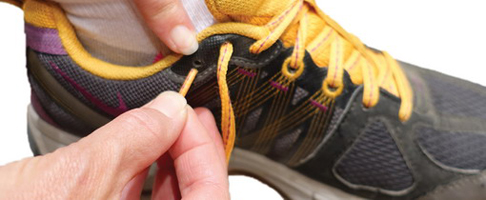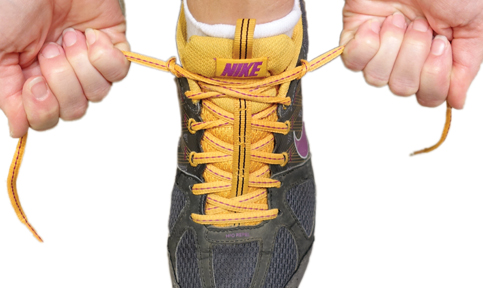
It’s an almost ironclad rule: Sooner or later, you’re going to have to wear clothes.
Considering how much time you’re going to spend in them and around them, you may as well master their darkest secrets.
The right way to tie your shoes
Maybe you know a kid. Maybe you were once a kid. Either way, you know about the tendency of shoelaces to come untied.
The reason is very simple: You’ve been tying your shoes wrong your whole life.
To use the technical term, you’ve been tying granny knots. You can tell because the loops of the bow have a tendency to run heel to toe, rather than lying nicely horizontally.
By making a simple change in the usual bow-tying sequence, you can produce the correct, sturdy bowknot instead of the granny—and the shoes won’t come untied.
You know the first step of tying your shoes, the part where you tuck one lace under the other and pull tight (Figure 1)?

The trick is to reverse the laces. Instead of wrapping the left end over the right, wrap the right end over the left (Figure 2). When you complete the bowmaking business and pull tight, the loops lie horizontally across the shoe—and the knot won’t come undone!
The right way to untie your shoes
When you want to undo shoelaces you’ve tied in the standard bow, it’s annoying, isn’t it, when you grab the wrong end? You pull it and wind up making only a tighter knot?
That won’t happen anymore. Because now you know that you should always grab the shorter loose end. When you tug that one, the knot always dissolves.
The mystery of the extra shoelace hole
They’ve been there for years, mystifying anyone who bothered to ponder them: an extra set of shoelace holes on running shoes, right near the ankle. They’re slightly out of alignment with the regular holes—so what are they for?
They’re for a heel lock. That’s a special lace-tying technique that does a better job of securing the fabric of the shoe around your ankle—and minimizes the chance that your heel will slosh around while hiking (causing blisters) or that you’ll bang against the front of the shoe while distance running (causing black-toenail syndrome—don’t ask).
You create a heel lock (sometimes called a lace lock) before tying your shoe. First, run the lace that’s hanging off the right side through the top heel-lock hole of the same side, creating a loop; do the same on the left side.

Next, cross each lace end through the loop you’ve just made on the opposite side, as shown by the arrow below.

Cinch tight (pull down, not up) so that the shoe hugs the top of your foot.

Now tie your shoes as usual.
You’ll enjoy a much snugger fit—and the satisfaction of knowing, at last, why there are two extra holes in your shoes!
How to prevent your flip-flop plug from popping out
Yes, yes, OK, your flip-flops cost only $6, and they’re made of foam rubber from China. But it’s still a pain when you pull the toe-pole out of the little hole in the sole, sometimes ruining your footwear for good.
If you’d like to stave off that disaster, protect the plug with one of those plastic closing tabs from a bread wrapper—or cut out a disk from a margarine-tub lid. Either way, you’ve now got a hedge against flip-flop-plug pull-through.

Three things to do with a new men’s suit jacket
Cut off the little white tags on the sleeves.
Cut open the sewn-shut pockets. (They’re not supposed to stay shut.)
Pull off the white basting thread on the shoulders and vents.
Men’s clothing: The Basics
Here, guys. This tidy list spares you 10 years of reading GQ and Esquire to glean the essentials of what’s considered modern style.
• Your shoes and belt should match: brown with brown, or black with black.
• No matter how many buttons your jacket has, don’t button the bottom one.
• Don’t wear suspenders and a belt; one at a time.
• Your pants should be long enough to touch and “break” (bend) slightly at the tops of your shoes.
• Your sleeve should show about a half inch of shirt at your wrist.
• When it’s tied right, the tip of the tie should touch the top of your belt.
• When wearing shorts, no socks (at least no visible ones).
• No socks with sandals.
• The socks should match the pants.
• White socks: for athletics only.
• If you tuck in your shirt, wear a belt.
Of course, the essence of style is being who you are; nobody should be able to tell you how to dress!
On the other hand: Before you become a rule-breaker, it’s often helpful to know what the rules are.
The Great American Dictionary of Dress-Code Shorthand
There it is, on your invitation to something: “Business casual.” Or “Smart casual.” Or “Active attire.” Or “Informal.” What are they supposed to mean, and what’s the ranking of formality? You don’t want to be the only one at the boss’s retirement party wearing shorts, right?
Here’s a hugely simplified cheat sheet.
• White tie. Men: black dress coat or tailcoat, white vest, white bow tie. Women: floor-length evening gown.
• Black tie. Men: tuxedo, black vest or cummerbund. (If it says “Black tie optional,” then a dark suit and tie are OK, too.) Women: long evening gown or dressy cocktail dress.
• Semiformal. Men: dark business suit, tie. Women: cocktail dress; long, dressy skirt and top; or little black dress.
• Festive attire. Men: sport coat, open-collar shirt, slacks. Women: cocktail dress; long, dressy skirt and top; or dressy pants outfit.
• Business formal. Men: dark business suit, tie. Women: suit, business-style dress, or dress with jacket.
• Cocktail attire/informal. Men: dark suit. Women: short, elegant dress.
• Business casual/smart casual. Dozens of definitions are bubbling through the clothesosphere. But this much is clear: For men, it’s slacks and a collared or a button-down shirt. (A blazer is sometimes mentioned.) For women, pants or knee-length skirt, and blouse or collared shirt. For both: no jeans, no shorts, no athletic wear.
• Casual. Anything. Jeans, T-shirt or polo shirt, sneakers—all fine.
How to find that contact lens, tiny screw, or earring
Dropped it on the floor, did you? Don’t do that hilarious thing they always do in movies, where the guy who dropped the object walks around, slowly peering across the floor, until his next step produces a sickening crunch.
Instead, use a rubber band to strap a piece of thin cloth or mesh over the end of a vacuum-cleaner nozzle. Use a piece of nylon stocking, for example, or a thin sock, cloth handkerchief, or T-shirt.

As you slowly vacuum the floor, the suction will eventually pluck up your contact lens, screw, or earring—and make it stick to the fabric.
Laundry: The Basics
If you’ve been doing laundry for years, congratulations! But if you’re just starting out in the washer/dryer room, here are the principles:
• Wash white and light-colored clothes separately from dark and colored clothes. That’s to avoid the dye from the dark clothes running onto the light ones. (Red polo shirt + white underwear = pink undies.)
• Inspect each article before you put it into the machine. Check the pockets. If you see a stain, spray it, front and back, with a pretreating spray or gel like Resolve, Tide Boost, or Shout.
• In the days of yore (yore parents, for example), you were told to use warm water for whites/lights, and cold water for colored/dark clothing. These days, though, liquid laundry detergent is formulated to work in hot or cold water—so now you can use cold water for all your laundry. Yes, radical but true. Your clothing will last longer, and you’ll save money, because your hot-water heater can take a break.
• Pour the detergent into the bottle cap, which serves as a measuring cup, and empty the detergent into the washing machine.
• When the washing cycle is complete, pull out each piece of clothing and shake it out before putting it into the dryer.
• The dryer is deadly for the four s’s: sexy, stretchy, see-through, or sweatery.
• Don’t hang stretchy or sweatery to dry, either—it will stretch. Lay it flat to dry.
How to choose the right eyeglass frames for your face
Maybe you’ll find a pair of frames and fall in love with them. In that case, great.

But if you need some guidance, here’s what the experts say: The shape of your face should determine the style of the glasses. In general, the frame shape should contrast with your face shape, and the glasses size should be in proportion to your face size.
What’s the basic outline of your face? Here are the five standard shapes, along with the usual recommendations for frames that will make you look your best:
• Triangular. Widest at the jaw, narrower forehead. Glasses: Choose frames that are slightly wider than your jawline, to balance your face. Something fancy on the top of the frames (a thick top edge, cat-eye frames, detailing) also helps balance your broad jaw.
• Round. Rounded forehead, round chin, soft jawline. Glasses: Choose squarish or rectangular frames. You want to add angles, preferably wider than tall. Avoid round frames and oversize ones.
• Oval. Narrow forehead and tapered chin. Glasses: Any style except oversize ones.
• Heart-shaped. Wide forehead, narrow chin. Glasses: You’re supposed to minimize the width of your forehead. So avoid top-heavy, wide-top, or cat-eye frames.
• Squarish. Wide forehead and cheeks, broad chin or strong jawline. Glasses: You want to soften the angles of your facial structure by adding curves, so round lenses work well. Avoid boxy or top-heavy frames. Try frames that are wider than your face’s widest point.